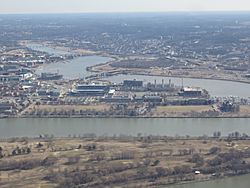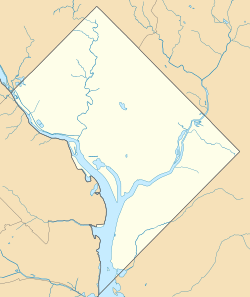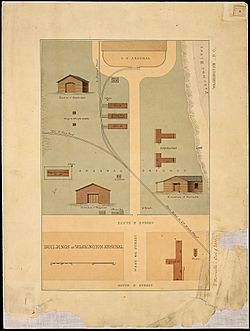Fort Lesley J. McNair facts for kids
Quick facts for kids Fort Lesley J. McNair |
|
|---|---|
| Buzzard Point, Washington, D.C. | |

Fort McNair in 2019
|
|
| Coordinates | 38°52′01″N 77°00′58″W / 38.867°N 77.016°W |
| Type | Military base |
| Site information | |
| Controlled by | United States Army |
| Site history | |
| In use | 1791–present |
| Garrison information | |
| Garrison | Military District of Washington |
| Occupants |
|
Fort Lesley J. McNair is a United States Army post located on the tip of Greenleaf Point, the peninsula that lies at the confluence of the Potomac River and the Anacostia River in Washington, D.C. To the peninsula's west is the Washington Channel, while the Anacostia River is on its south side. Originally named Washington Arsenal, the fort has been an army post for more than 200 years, third in length of service, after the United States Military Academy at West Point and the Carlisle Barracks. The fort is currently named for General Lesley J. McNair, who was killed in action in World War II.
Contents
History
Early history
The military reservation was established in 1791, on about 28 acres (110,000 m2) at the tip of Greenleaf Point. Major Pierre Charles L'Enfant included it in his plans for Washington, the Federal City, as a major site for the defense of the capital. On L'Enfant's orders, Andre Villard, a French follower of Marquis de Lafayette, placed a one-gun battery on the site. In 1795, the site became one of the first two United States arsenals.
An arsenal first occupied the site and defenses were built in 1794. However, the fortifications did not halt the invasion of British forces in 1814, who burned down many public government buildings in Washington, D.C., during the War of 1812. Soldiers at the arsenal evacuated north with as much gunpowder as they could carry, hiding the rest in a well as the British soldiers came up the Potomac River after burning the Capitol. About 47 British soldiers found the powder magazines they had come to destroy empty. Someone threw a match into the well and "a tremendous explosion ensued," a doctor at the scene reported, "whereby the officers and about 30 of the men were killed and the rest most shockingly mangled."
The remaining soldiers destroyed the arsenal buildings, but the facilities were rebuilt from 1815 to 1821, with eight buildings arranged around a quadrangle, and named the Washington Arsenal. In the early 1830s, four acres of marsh land were reclaimed and added to the arsenal, and a seawall and additional buildings were constructed. Between 1825 and 1831, the penitentiary was constructed on the arsenal with a three-story block of cells, administrative buildings, and a shoe factory for teaching prisoners a trade. In 1857, the federal government purchased additional land for the site. By 1860, the arsenal had used one of the first steam presses, developed the first automatic machine for manufacturing percussive caps, and experimented with the Hale Rocket. A large civilian workforce manufactured ammunition at the arsenal, and the site included a large military hospital.
Explosion
During the Civil War, women worked in an ammunition factory at the Washington Arsenal. Many lower-class women—including Irish immigrants—needed wages, especially after male relatives went to war. Women were believed to have nimble fingers, attention to detail, and a tendency to neatness suitable for rolling, pinching, tying, and bundling cartridges with bullets and black powder.
On June 17, 1864, fireworks left in the sun outside a cartridge room ignited, killing twenty-one women, many of whom burned to death in flammable hoop skirts. The War Department paid for their funerals, and President Lincoln attended the joint funeral procession. A monument at Congressional Cemetery commemorates these women. In memory of the many Irish victims, the Irish foreign minister laid a wreath at Congressional Cemetery memorial during 150th anniversary commemorations in 2014.
Lincoln conspirators' trial
The conspirators accused of assassinating president Abraham Lincoln were imprisoned there, tried by military commission and, after being found guilty, four were hanged and the rest received prison sentences.
One of the buildings on the complex, Ulysses S. Grant Hall, is the location of the 1865 military tribunal of the conspirators of the assassination of Abraham Lincoln. The hall periodically holds public open houses, where each quarter of the hall is open to the public and people can visit the courtroom and learn more about the trials. A hospital was built next to the penitentiary in 1857, and wounded Civil War soldiers were treated at what then was called the Washington Arsenal. The arsenal was closed in 1881, and the post was transferred to the Quartermaster Corps.
Walter Reed
A general hospital, the predecessor to the Walter Reed Army Medical Center, was located at the post from 1898 until 1909. Major Walter Reed found the area's marshlands an excellent site for his research on malaria. Reed's work contributed to the discovery of the cause of yellow fever. Reed died of peritonitis after an appendectomy at the post in 1902. The post dispensary and the visiting officers' quarters now occupy the buildings where Reed worked and died.
20th century
About 90% of the present buildings on the post's 100 acres (0.40 km2) were built, reconstructed or remodeled by 1908. In 1901, with the birth of the Army War College, the post, now called Washington Barracks, became the army's center for the education and training of senior officers to lead and direct large numbers of troops. Its first classes were conducted in 1904 in Roosevelt Hall, the iconic building designed by the architectural firm of McKim, Mead and White.
The Army Industrial College was founded at McNair in 1924 to prepare officers for high-level posts in Army supply organizations, and to study industrial mobilization. It evolved into the Industrial College of the Armed Forces. The post was renamed Fort Humphreys in 1935 – a name previously assigned to today's Fort Belvoir. The Army War College was reorganized as the Army-Navy Staff College in 1943, and became the National War College in 1946. The two colleges became the National Defense University in 1976.
The post was renamed in 1948 to honor Lieutenant General Lesley J. McNair, commander of army ground forces during World War II, who was headquartered at the post and was killed during Operation Cobra near Saint-Lô, France, on July 25, 1944. He was killed in an infamous friendly fire incident when errant bombs of the Eighth Air Force fell on the positions of 2nd Battalion, 120th Infantry, where McNair was observing the fighting. Fort McNair has been the headquarters of the Military District of Washington since 1966.
Current status
Fort McNair, a part of the Joint Base Myer–Henderson Hall, is the headquarters of the Army's Military District of Washington and home of the National Defense University, as well as the official residence of the Vice Chief of Staff of the United States Army.
Tenants
National Defense University
The National Defense University represents a significant concentration of the defense community's intellectual resources. Originally established in 1976, the university includes the National War College and the Dwight D. Eisenhower School for National Security and Resource Strategy (formerly the Industrial College of the Armed Forces) at Fort McNair, and the Joint Forces Staff College in Norfolk, Virginia. These and other schools are separate entities, but their close affiliation enhances the exchange of faculty expertise and educational resources, promotes interaction among students and faculty and reduces administrative costs. The National War College and the Eisenhower School concentrate on preparing civilian and military professionals in areas of national security strategy, decision-making, joint and combined warfare and the resource component of national strategy. The Joint Forces Staff College, established under the Joint Chiefs of Staff in 1946, prepares selected officers for joint and combined duty.
In 1990, the Information Resources Management College was formed as the capstone institution for Defense Information Resource Management education. As such, it provides graduate-level courses in information resources management. The National Defense University also features a first-rate research capability through the Institute for National Strategic Studies. This institute, established in 1984, conducts independent policy analyses and develops policy and strategy alternatives. It also includes a War Gaming and Simulation Center and the NDU Press.
The university has several other educational programs. These include the Capstone program, for general and flag officer selectees; the International Fellows program, which brings NDU almost 100 participants from 50 different countries; and the Reserve Components National Security Course, which offers military education to senior officers of the armed forces.
Inter-American Defense College
The Inter-American Defense College is an advanced-studies institute for senior officers of the 25-member nations of the Inter-American Defense Board. Up to three students of the rank of colonel or the equivalent may be sent to the college by each member nation. The students' backgrounds must qualify them to participate in the solution of hemispheric-defense problems.
The officers study world alliances and the international situation; the inter-American system and its role; strategic concepts of war; and engage in a planning exercise for hemispheric defense. The college has been at Fort McNair since 1962.
United States Army Center of Military History
In September 1998, the United States Army Center of Military History moved from rented offices in Washington, D.C., to Fort McNair in historically preserved quarters remodeled from its previous use as a commissary and before that as Fort McNair's stables. The center dates from the creation of the Army General Staff historical branch in July 1943 and the gathering of a team of professional historians, translators, editors, and cartographers to record the history of World War II. That effort led to a monumental 79-volume series known as the "Green Books."
Today, the center operates through four divisions, the histories division being the one most involved in writing the histories and providing historical research support to the Army staff. The field program and historical services guides work done at various posts and installations, as well as the work by deployed historical detachments for Army operations, ensures historical information is comprehensive and factual.
Another division is responsible for overseeing the Army museum system and preservation of artifacts and artwork that are the army's historical treasure. One such museum, The Old Guard Museum, was located at Fort Myer until it was closed. The center's publishing division generates finished publications and assures access to the center's work through such media as CD-ROM and the World Wide Web.
Images for kids













